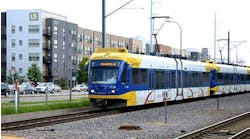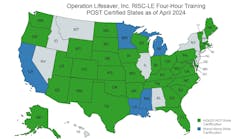The following information was released by Connecticut Senator Joseph I. Lieberman:
Homeland Security and Governmental Affairs Committee Chairman Joe Lieberman, ID-Conn., Wednesday said rail and transit security in the U.S., and particularly in Connecticut, has improved since 9/11 but needs continued attention to boost security to a higher level - particularly since recent evidence recovered from Osama bin Laden's hideout suggests that rail systems remain key terrorist targets.
At a hearing entitled "See Something, Say Something, Do Something," discussion focused on the essential role of mass transit and rail passengers to stay alert, report suspicious behavior, and understand the risks.
"We must continue to work with travelers to make them full partners in securing our rail and transit systems," Lieberman said. "This includes educating them about risks, how to report suspicious activity, and how to respond and recover should an attack occur." (click here to watch video of Lieberman's remarks)
Witness Peter Boynton, Commissioner of the Connecticut Department of Emergency Management and Homeland Security, stressed the need for cooperation among jurisdictions and agencies to maintain security. But he worried that dwindling federal funds for Connecticut rail and transit security could inadvertently increase the risk to the state.
"The interconnected nature of mass transit means that the security of the New York City transit system relies in part on the security of the Connecticut-based portion of the transit system," Boynton said. "Connecticut's situation is not unique. This type of feeder rail system exists elsewhere around the country, where rail lines from surrounding communities meet in the larger urban areas.
"From the state perspective, however, we are increasingly seeing federal funding being shifted to large urban areas. The focus on security for cities makes sense in many respects, but shrinking security funding for communities with transit links into large urban areas may have the unintended consequence of pushing the risk outside the urban area and increasing the vulnerability for terrorists to prepare outside the city for terrorist activity intended within the city.
"Connecticut has had real experience within its borders with this phenomenon, including the terrorists involved in the 9/11 attacks and the attempted Times Square bombing - both cases where terrorists intending to attack New York City were in Connecticut." (click here to watch video of Boynton's remarks)
The House of Representatives is proposing that DHS's Transit Security Grant Program be zeroed out for Fiscal Year 2012. Lieberman called the plan "just plain bad policy."
Fourteen million people use rail and mass transit systems every day in this country -seven times the number who fly aboard airplanes each day. In Connecticut, rail systems carry 127,000 passengers per day for 37 million passenger trips to and from New York City in 2010.
Rail and transit security has long been a complicated issue because rail systems cannot be tightly secured like aviation systems without impeding the flow of traffic because of their open nature and the number of passengers who ride them. Since September 11, 2001, violent Islamist extremists have targeted railroads and mass transit in Washington D.C., New York, Mumbai, Madrid, London, and Moscow - often with devastating success.
Although rail and transit security is primarily the responsibility of state and local law enforcement and rail operators, the Transportation Security Administration has a critical role to play. Lieberman said:
- TSA must fulfill a 2007 legislative requirement to develop uniform standards for rail and transit training programs, for background checks for frontline employees, and for transit agencies' security plans.
- The Department of Homeland Security must step up its efforts to develop creative, non-intrusive security solutions - especially to detect improvised explosive devices, which history has shown are the weapon of choice for disrupting rail and transit systems.
- TSA must improve its intelligence sharing with state and local officials, and the private sector.
- All stakeholders should conduct more exercises to accustom rail and transit officials to the unique requirements of disaster prevention and response involving trains.
- Make passengers full partners in rail and transit security, educating them about risks, how to report suspicious activity, and how to respond should an attack occur.
In addition to Boynton, witnesses at the hearing included Transportation Security Administrator John Pistole and Steve Flynn, President of the Center for National Policy.
# # #
Copyright 2008 LexisNexis, a division of Reed Elsevier Inc. All rights reserved.
Terms and Conditions | Privacy Policy


